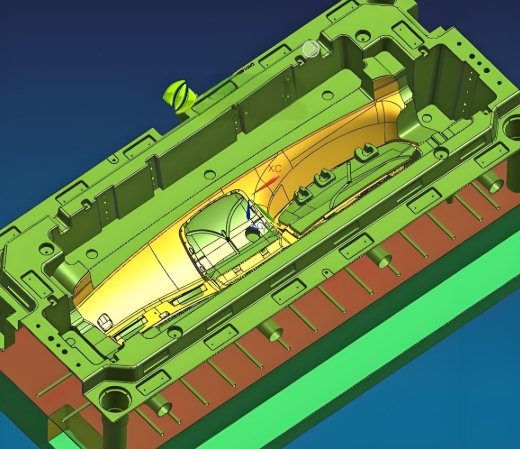
Advanced Driver Assistance Systems (ADAS) improve vehicle safety. These systems use cameras, sensors, and control units. Automotive injection molds create precise plastic components for ADAS. A skilled mold maker ensures accuracy in every part.
Why ADAS Needs High-Quality Injection Molds
ADAS parts must be accurate. Even small errors affect performance. Automotive injection molds ensure precise manufacturing. A reliable mold maker helps maintain strict quality standards.
Key ADAS Components Made with Injection Molding
1. Camera Housings
Cameras monitor traffic, lanes, and obstacles. Their housings must be durable and lightweight. Automotive injection molds create strong, heat-resistant enclosures.
2. Radar Covers
Radar sensors detect vehicles and objects. Their covers protect sensitive electronics. A skilled mold maker ensures a perfect fit.
3. Sensor Mounts
Sensors track speed, distance, and movement. Strong mounts prevent vibration. Injection molding ensures secure placement.
4. Control Module Casings
ADAS modules process data. Their casings protect circuits from heat and moisture. Automotive injection molds create durable enclosures.
5. Display Panels
ADAS displays show real-time data. Injection-molded plastic creates clear, durable screens. A mold maker ensures precision.
Benefits of Injection Molding for ADAS
1. High Precision
ADAS requires accurate components. Injection molding ensures exact dimensions.
2. Lightweight Parts
Plastic reduces overall vehicle weight. Lighter cars improve fuel efficiency.
3. Cost-Effective Manufacturing
Mass production lowers costs. Automotive injection molds ensure efficiency.
4. Heat and Impact Resistance
ADAS parts face extreme conditions. Injection-molded materials withstand heat and impact.
5. Consistency in Production
Every part meets the same standards. This ensures reliability and safety.
The Role of a Mold Maker in ADAS Development
A mold maker plays a key role in ADAS production. They design, test, and refine molds for high precision.
1. Designing the Mold
Engineers create 3D models. The design must match ADAS component requirements.
2. Choosing the Right Material
High-performance plastics improve durability. A mold maker selects the best option.
3. CNC Machining for Accuracy
CNC machines cut molds with extreme precision. Every part fits perfectly.
4. Testing for Quality
Molds go through strict testing. This ensures flawless performance.
Different Types of Injection Molds for ADAS
1. Single-Cavity Molds
These molds create one part at a time. They ensure high precision.
2. Multi-Cavity Molds
These molds produce multiple parts in one cycle. They improve efficiency.
3. Hot Runner Molds
These molds reduce waste. They speed up production.
4. Overmolding
This process combines multiple materials. It enhances durability.
5. Insert Molding
Plastic is molded around metal inserts. This strengthens the part.
Challenges in ADAS Mold Manufacturing
1. Complex Designs
ADAS components have intricate shapes. A skilled mold maker ensures precision.
2. Material Selection
Different plastics offer different properties. Choosing the right material is critical.
3. Strict Safety Standards
ADAS must meet high industry standards. Even small defects can cause failure.
4. Cost Management
Custom molds require investment. However, they reduce long-term costs.
5. Rapid Technological Changes
ADAS technology evolves quickly. Mold makers must adapt to new designs.
Innovations in Injection Molding for ADAS
1. 3D Printing for Prototyping
Rapid prototyping speeds up development. Engineers test new designs quickly.
2. AI-Powered Mold Design
Artificial intelligence optimizes mold geometry. This improves efficiency.
3. Sustainable Materials
Eco-friendly plastics reduce environmental impact. The industry moves toward greener solutions.
4. Automation in Manufacturing
Robotic systems increase accuracy. They reduce human error.
How Injection Molding Improves ADAS Production
1. Faster Production Cycles
Injection molding allows rapid part creation. This speeds up ADAS manufacturing.
2. Higher Quality Standards
Every part meets exact specifications. This ensures consistency.
3. Cost Savings in Mass Production
Custom molds may be expensive upfront. However, they reduce costs in large-scale manufacturing.
4. Improved Vehicle Performance
Lightweight and durable parts enhance efficiency. Vehicles become safer and more reliable.
Future of Injection Molding in ADAS
Custom automotive injection molds continue to evolve. Electric and autonomous vehicles require advanced molding techniques. A skilled mold maker plays a key role in future developments. The demand for precision and innovation grows every year.
Automotive injection molds shape the future of ADAS. They ensure precision, durability, and efficiency. A professional mold maker designs molds that meet exact automotive standards. As technology advances, injection molding will play an even bigger role in ADAS development.
